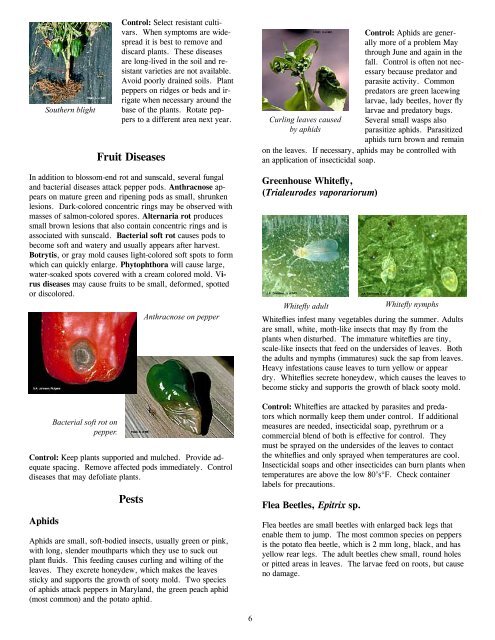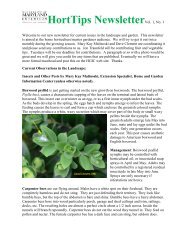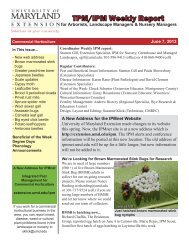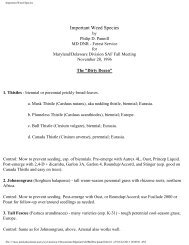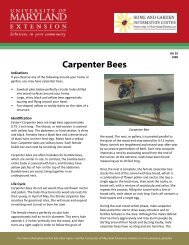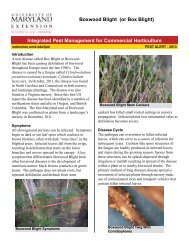IPM Series: Peppers (HG 57) - University of Maryland Extension
IPM Series: Peppers (HG 57) - University of Maryland Extension
IPM Series: Peppers (HG 57) - University of Maryland Extension
You also want an ePaper? Increase the reach of your titles
YUMPU automatically turns print PDFs into web optimized ePapers that Google loves.
Southern blight<br />
Control: Select resistant cultivars.<br />
When symptoms are widespread<br />
it is best to remove and<br />
discard plants. These diseases<br />
are long-lived in the soil and resistant<br />
varieties are not available.<br />
Avoid poorly drained soils. Plant<br />
peppers on ridges or beds and irrigate<br />
when necessary around the<br />
base <strong>of</strong> the plants. Rotate peppers<br />
to a different area next year.<br />
Fruit Diseases<br />
In addition to blossom-end rot and sunscald, several fungal<br />
and bacterial diseases attack pepper pods. Anthracnose appears<br />
on mature green and ripening pods as small, shrunken<br />
lesions. Dark-colored concentric rings may be observed with<br />
masses <strong>of</strong> salmon-colored spores. Alternaria rot produces<br />
small brown lesions that also contain concentric rings and is<br />
associated with sunscald. Bacterial s<strong>of</strong>t rot causes pods to<br />
become s<strong>of</strong>t and watery and usually appears after harvest.<br />
Botrytis, or gray mold causes light-colored s<strong>of</strong>t spots to form<br />
which can quickly enlarge. Phytophthora will cause large,<br />
water-soaked spots covered with a cream colored mold. Virus<br />
diseases may cause fruits to be small, deformed, spotted<br />
or discolored.<br />
Bacterial s<strong>of</strong>t rot on<br />
pepper.<br />
Anthracnose on pepper<br />
Control: Keep plants supported and mulched. Provide adequate<br />
spacing. Remove affected pods immediately. Control<br />
diseases that may defoliate plants.<br />
Aphids<br />
Pests<br />
Aphids are small, s<strong>of</strong>t-bodied insects, usually green or pink,<br />
with long, slender mouthparts which they use to suck out<br />
plant fluids. This feeding causes curling and wilting <strong>of</strong> the<br />
leaves. They excrete honeydew, which makes the leaves<br />
sticky and supports the growth <strong>of</strong> sooty mold. Two species<br />
<strong>of</strong> aphids attack peppers in <strong>Maryland</strong>, the green peach aphid<br />
(most common) and the potato aphid.<br />
Curling leaves caused<br />
by aphids<br />
Control: Aphids are generally<br />
more <strong>of</strong> a problem May<br />
through June and again in the<br />
fall. Control is <strong>of</strong>ten not necessary<br />
because predator and<br />
parasite activity. Common<br />
predators are green lacewing<br />
larvae, lady beetles, hover fly<br />
larvae and predatory bugs.<br />
Several small wasps also<br />
parasitize aphids. Parasitized<br />
aphids turn brown and remain<br />
on the leaves. If necessary, aphids may be controlled with<br />
an application <strong>of</strong> insecticidal soap.<br />
Greenhouse Whitefly,<br />
(Trialeurodes vaporariorum)<br />
Whitefly adult<br />
Whitefly nymphs<br />
Whiteflies infest many vegetables during the summer. Adults<br />
are small, white, moth-like insects that may fly from the<br />
plants when disturbed. The immature whiteflies are tiny,<br />
scale-like insects that feed on the undersides <strong>of</strong> leaves. Both<br />
the adults and nymphs (immatures) suck the sap from leaves.<br />
Heavy infestations cause leaves to turn yellow or appear<br />
dry. Whiteflies secrete honeydew, which causes the leaves to<br />
become sticky and supports the growth <strong>of</strong> black sooty mold.<br />
Control: Whiteflies are attacked by parasites and predators<br />
which normally keep them under control. If additional<br />
measures are needed, insecticidal soap, pyrethrum or a<br />
commercial blend <strong>of</strong> both is effective for control. They<br />
must be sprayed on the undersides <strong>of</strong> the leaves to contact<br />
the whiteflies and only sprayed when temperatures are cool.<br />
Insecticidal soaps and other insecticides can burn plants when<br />
temperatures are above the low 80’s°F. Check container<br />
labels for precautions.<br />
Flea Beetles, Epitrix sp.<br />
Flea beetles are small beetles with enlarged back legs that<br />
enable them to jump. The most common species on peppers<br />
is the potato flea beetle, which is 2 mm long, black, and has<br />
yellow rear legs. The adult beetles chew small, round holes<br />
or pitted areas in leaves. The larvae feed on roots, but cause<br />
no damage.<br />
6


